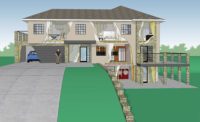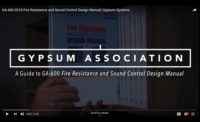Gypsum panel product manufacturers are constantly innovating and developing new and improved products in response to the needs of architects, builders and owners. In fact, the spirit of innovation dates back to the birth of the gypsum board concept. When Augustine Sackett formed the Sackett Plaster Board Company in 1906, he was building on his success as the inventor of a machine that produced building papers. Sackett Board, the progenitor of drywall, was composed of layers of felt paper and gypsum and Sackett ultimately patented both the product and the equipment and method of producing it.
After establishing the company, Sackett launched an advertising campaign touting the advantages of his new fire-resistant board in major publications such as The House Beautiful, Country Life, and the Saturday Evening Post. “Every architect owes it to his clients, every owner owes it to himself, to investigate this material before making old-style specifications, reads a full-page ad that appeared in the July 1906 edition of The House Beautiful. “It can be used to good advantage somewhere in every building.”
Significant improvements to Sackett’s concept resulted in the wallboard that has come to dominate interior walls today but gypsum board manufacturers haven’t stopped there. In recent years, manufacturers have introduced specialized performance panels aimed at addressing specific design challenges. Produced by all Gypsum Association member companies, these specialty products include exterior gypsum sheathing, abuse-resistant and impact-resistant gypsum panels, mold/moisture resistant panels and, finally, gypsum shaftliner.
All of these materials add value, increase resiliency, and reduce lifecycle costs while providing the fire-resistance that has made gypsum panel products so ubiquitous in construction. In addition to fire resistance, however, newer specialized performance panels provide mold and moisture resistance, extended weatherability and increased durability. Other specialized performance products, such as exterior gypsum sheathing and gypsum shaftliner, have become viable alternatives to wood and/or masonry products. Moreover, even as they address significant problems, these gypsum panel products retain a signature feature of traditional boards, namely, they are easily installed using tools and trades already on the job site.
Yet, the perception among GA member companies was that opportunities for the use of these performance panels were being overlooked, perhaps in favor of what Sackett’s contemporaries might have called, “old-time specifications.” In 2015, the Gypsum Association tested that assumption by surveying the A/E/C community on the topic. Our goal: To measure the actual level of awareness and knowledge of specialized performance boards.
Target Audiences
Although the GA targeted architects and specifiers, the hope was to capture the views of engineers and general contractors as well. This online survey garnered 567 responses, most (77 percent) from architects and specifiers, with engineers (8 percent), and a variety of contractors and other construction professionals comprising the remainder of those surveyed. A total of 567 responses were received. Practically speaking the survey produced an overall confidence level of 95-96 percent with a margin of error of plus or minus 4-5 percent.
Survey respondents worked within the full range of vertical construction sectors, from single-family homes (28 percent) and multifamily residential (33 percent) to K-12 (26 percent) and higher education (27 percent). Obviously, many professionals worked on multiple projects types. Sixty-seven percent, for example, reported working in commercial construction defined for the purposes of the survey as retail, office, or warehouse, while still others (30 percent) reported designing healthcare facilities (nursing homes, hospitals, and clinics). Local, state, or federal building work (38 percent) was yet another flourishing practice area among survey takers.
Educating Users
Questions probing at respondents’ awareness of specialized performance panels, history of use over the past three years, and likelihood of future use suggested that awareness and use of these products does fall short of optimization, albeit with variations across product categories and project types. Respondents reported that they learn about products overwhelmingly from industry shows, sales reps, professional education, press/advertising, and other design professionals. Ninety-two survey participants answered a single open-ended question, namely, “Please feel free to comment on your past or future use of the specialized performance boards.”
Some of those who commented were very familiar with specialized performance boards, citing the use of impact-resistant gypsum panels in hospitals, the specification of abuse-resistant gypsum panels in schools and even saying, “There is no turning back to what we refer to as regular gypsum board unless it is for certain interior partitions. Why not incorporate the latest technologies?”
Comments from contractors suggested designers were unwilling to specify performance boards, while architects said contractors resisted their use, and that owners didn’t understand the value these newer products offer. This kind of finger pointing is hardly unusual in the A/E/C sector, but it signaled the need for greater education on gypsum panel variants across the spectrum of design and construction professionals as well as their clients.
In fact, many respondents were quite frank about their desire for more information on specialized performance boards. “I have been lacking performance specs [for] these items,” said one, a sentiment that was echoed by several. “Unless it’s in a journal I read or I see it at a trade show, I won’t know about it,” another respondent noted. “Keep up the information stream,” was the advice of one architect.
Interview Sessions
To supplement the quantitative data collected through the survey, GA staff made every attempt to capture qualitative data through informal “intercept” interviews at industry events. At GreenBuild 2015, for example, we learned that a senior specifier of a top 10 U.S. architecture/engineering firm was aware of new categories of gypsum panels. However, he admitted, “We just don’t know enough about them.” He encouraged industry efforts to “educate [architects] so we can effectively use these products.”
Lacking knowledge and awareness of these innovative gypsum panels, design and construction professionals and their clients are not fully benefiting from the advantages they offer. Moreover, as the association charged with promoting the use of gypsum and advancing the general welfare of the gypsum industry on behalf of our member companies, addressing this information gap with generic and impartial information was certainly within the GA’s purview.
Educating the design and construction community on these multi-attribute performance products is an important contribution to the A/E/C value chain and, today, visitors to the GA website will find two new sections devoted to specialized performance gypsum panels in multi-family and commercial construction. Each performance panel type is illustrated in situ, with physical description, advantages, and limitations noted. Answers to frequently asked questions are supplied for each performance board. Citations and links to all pertinent ASTM Standards and GA technical and code referenced documents are provided. In addition, a new section on the basics of sound control addresses an increasingly important and code referenced aspect of indoor environmental quality. Most specialized performance boards can play the same role in sound attenuation as do traditional wallboards. As a result, the acoustics section emphasizes system solutions to sound attenuation.
Interested in learning more about specialized performance gypsum panels? I encourage you to visit gypsum.org, where alongside our traditional guidance and technical documents you can now find out about these innovative products produced by all association member companies. Discover how and where specialized performance boards are properly specified, what standards govern their application and use, and most importantly, how they address specific issues in both multi-family and commercial construction.
Having difficulty convincing a client, architect, or installer of the value-added benefits of these products? Again, the GA is here with impartial information that can enhance your next project. To paraphrase Sackett’s 100-year-old advertisement, “Specialized performance boards can be used to good advantage somewhere in every building.” Or as we at the association have come to say when confronted with issues related to mold and moisture, extended exposure to the elements, concerns about life-cycle costs, or difficult rehabs and retrofits, “There’s a board for that!”






Report Abusive Comment